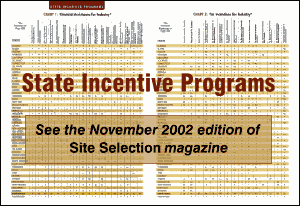C |
ompanies facing earnings pressures are taking public-sector incentives more seriously during these challenging economic times, according to a survey recently completed by Stadtmauer Bailkin Biggins (SBB), L.L.C [a firm where the author is a principal]. The study, which queried both corporate real estate executives and economic development agencies on developing trends in incentives, was previewed at the May 2002 CoreNet Global Summit in Salt Lake City. The SBB survey found that three out of four corporate real estate executives believe that tax and other public-sector incentives continue to play a critical role in their decisions to locate investment and jobs during periods of economic stress. Also, in a sign of the times, more than one-half of these executives foresaw the need to restructure the job creation and other performance obligations contained in certain incentives agreements in the face of corporate downsizing and consolidation.
Perhaps because of the weak economy, economic developers responding to the SBB survey were not as convinced as their corporate counterparts that incentives make the difference in business-location decisions during periods of economic slowdown. This outlook may reflect the lower property costs and labor costs during recession; or it may be an attempt to put a brave face on a situation that may be largely out of their hands. After all, it is the lawmakers and state budget officials who will ultimately determine the fate of many incentive programs.
State Budgets Under the Gun
In the face of mounting budget pressures and unexpected public costs for security measures in the aftermath of 9-11, state lawmakers are trimming spending across the board, including, in some states, funding for economic development incentives. According to The Nelson A. Rockefeller Institute, state tax revenues have experienced their largest quarterly drop in over a decade, while the National Conference of State Legislatures now projects that economic conditions will cause a $57.4 billion aggregate state budget gap in 2003, more than double the deficit forecast just last spring. While some states have maintained funding for incentives as investments in growth, others have seen no alternative. The growing toll of diminished incentives programs includes a number of high-profile state programs, such as Virginia’s Governor’s Opportunity Fund, Indiana’s 21st Century Research and Technology Fund, economic development loan funds available from California’s Technology, Trade and Commerce Agency, Rhode Island’s Job Creation Tax Credits and the Missouri Dept. of Economic Development’s tax credit programs.
Trimming economic development incentives may provide states and localities with some temporary fiscal benefits, but such a choice may prove quite costly over the long-term. Budget deficits present states with a Hobson’s choice. Spending cuts that close budget gaps this year and next must target current spending commitments. Because such cuts are applied to existing incentives arrangements with companies that have already made location decisions, the business community would justly consider this a serious breach of faith which would have long-term implications for the states’ ability to compete. On the other hand, states that continue to fund their incentives in a reliable and predictable manner will have an immediate competitive advantage and a head-start in the race for new investment when the economy improves. — Jay Biggins
a strategic consulting and transaction services firm based in New York City and Princeton, N.J. For a copy of these and other findings, please visit:
www.SBB-Incentives.com.

